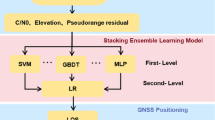Abstract
Automated driving technology relies heavily on continuous, high-precision, and high-reliability positioning in complex urban situations. With the mass production of autonomous vehicles, the issue of keeping equipment as cheap as possible while maintaining precision is getting much attention. The low-cost global navigation satellite system (GNSS)/micro-electro-mechanical system (MEMS) integrated navigation system, as the mainstream solution, is often faced with MEMS dead-reckoning rapid divergence during GNSS outages. Meanwhile, the high-definition maps (HD maps), as the positioning resource which stores the absolute coordinate information, cover urban roads more and more perfectly. In this case, we propose a method to enhance low-cost GNSS/MEMS integrated positioning by using a monocular camera and straight lane lines in HD maps. The positioning results are corrected by projecting lanes from OpenDRIVE maps onto the image, matching them with the visually detected ones, and minimizing the reprojected linear coefficients residuals. The algorithm can be embedded into GNSS/MEMS integrated navigation system as a module without breaking the architecture and increasing the cost. The feasibility and influencing factors were analyzed in simulation and field experiments. The tests demonstrate that positions in the lateral and up directions can be corrected to within 10 cm under current HD maps accuracy. Moreover, it is not seriously limited by the initial pose error, the number of lanes, and the road flatness. The results indicate that the lane coefficients-based algorithm is a potential module for enhancing the low-cost GNSS/MEMS integrated positioning performance.





















Similar content being viewed by others
Data availability
The data used in this manuscript are available from the corresponding author upon request.
References
ASAM (2020) Association for standardization of automation and measuring System OpenDRIVE 1.6.1 Specification [R/OL]. (2020–10–14) [2021–08–18]. https://www.asam.net/standards/detail/opendrive.
CAICV (2021) China industry innovation alliance for the intelligent and connected vehicles. High Definition Maps for the Intelligent and Connected Vehicles [R/OL]. (2021–05–27) [2021–08–18]. http://www.caicv.org.cn/index.php/material?cid=38.
CHCNAV (2017) CHCNAV i80 GNSS receiver data sheet [R/OL]. (2017–06–21) [2022–09–18]. https://www.chcnav.com/product-detail/i80-gnss.
Gao Z, Ge M, Shen W, Zhang H, Niu X (2017) Ionospheric and receiver DCB-constrained multi-GNSS single-frequency PPP integrated with MEMS inertial measurements. J Geod 91(11):1351–1366. https://doi.org/10.1007/s00190-017-1029-7
Hosseinyalamdary S, Peter M (2017) Lane level localization using images and HD maps to mitigate the lateral error. Int Arch Photogramm Remote Sens Spat Inf Sci - ISPRS Arch 42:129–134
Hunan Bynav Technology (2020) Bynav X1 Specification [R/OL]. (2020–05–29) [2022–09–18]. https://www.bynav.com/en/products/gnss-ins-integration/x-one.html.
Lategahn H, Schreiber M, Ziegler J, Stiller C (2013) Urban localization with camera and inertial measurement unit. In: IEEE Intelligent Vehicles Symposium, Proceedings. pp 719–724
Leopard Imaging Inc (2019), LI-USB30-AR023ZWDRB data sheet [R/OL]. (2019–03–15) [2022–09–18]. https://www.leopardimaging.com/uploads/LI-USB30-AR023ZWDRB_datasheet.pdf.
Li Z, Gao J, Wang J, Yao Y (2017) PPP/INS tightly coupled navigation using adaptive federated filter. GPS Solut 21(1):137–148. https://doi.org/10.1007/s10291-015-0511-z
Narote SP, Bhujbal PN, Narote AS, Dhane DM (2018) A review of recent advances in lane detection and departure warning system. Pattern Recognit 73:216–234. https://doi.org/10.1016/j.patcog.2017.08.014
Niu X, Nassar S, El-Sheimy N (2007) An accurate land-vehicle MEMS IMU/GPS navigation system using 3D auxiliary velocity updates. Navig J Inst Navig 54(3):177–188. https://doi.org/10.1002/j.2161-4296.2007.tb00403.x
Pan X, Shi J, Luo P, Wang X, Tang X (2018) Spatial as deep: Spatial CNN for traffic scene understanding. In: 32nd AAAI Conference on Artificial Intelligence, AAAI 2018. pp 7276–7283
Poggenhans F, Pauls JH, Janosovits J, Orf S, Naumann M, Kuhnt F, Mayr M (2018) Lanelet2: A high-definition map framework for the future of automated driving. In: IEEE Conference on Intelligent Transportation Systems, Proceedings, ITSC. pp 1672–1679
Qiu D, Li S, Wang T, Ye Q, Li R, Ding K, Xu H (2020) A high-precision calibration approach for Camera-IMU pose parameters with adaptive constraints of multiple error equations. Meas J Int Meas Confed 153:107402. https://doi.org/10.1016/j.measurement.2019.107402
SAE (2021) Society of Automotive Engineers On-Road Automated Vehicle Standards Committee. Taxonomy and Definitions for Terms Related to Driving Automation Systems for On-Road Motor Vehicles [J]. SAE Standard J, 2021.
Wu T, Ranganathan A (2013) Vehicle localization using road markings. In: IEEE Intelligent Vehicles Symposium, Proceedings. pp 1185–1190
Xiaomi Corporation (2018) MI MIX2S Specification [R/OL]. (2018–03–27) [2022–09–18]. https://www.mi.com/tw/mix2s/specs/
Yu YF, Zhao HJ, Cui JS, Zha H Bin (2017) Road Structural Feature Based Monocular Visual Localization for Intelligent Vehicle. Acta Autom Sin 43(5):725–734. https://doi.org/10.16383/j.aas.2017.c160413
Zhang X, Zhu F, Zhang Y, Mohamed F, Zhou W (2019) The improvement in integer ambiguity resolution with INS aiding for kinematic precise point positioning. J Geod 93(7):993–1010. https://doi.org/10.1007/s00190-018-1222-3
Acknowledgements
This work was supported by the National Key Research and Development Program of China (Grant No. 2020YFB0505803), the National Natural Science Foundation of China (Grant No. 42104021), the Science and Technology Major Project of Hubei Province (Grant No. 2021AAA010), and the Special Fund of Hubei Luojia Laboratory(220100005).
Author information
Authors and Affiliations
Corresponding author
Additional information
Publisher's Note
Springer Nature remains neutral with regard to jurisdictional claims in published maps and institutional affiliations.
Rights and permissions
Springer Nature or its licensor (e.g. a society or other partner) holds exclusive rights to this article under a publishing agreement with the author(s) or other rightsholder(s); author self-archiving of the accepted manuscript version of this article is solely governed by the terms of such publishing agreement and applicable law.
About this article
Cite this article
Xu, Q., Zhu, F., Hu, J. et al. An enhanced positioning algorithm module for low-cost GNSS/MEMS integration based on matching straight lane lines in HD maps. GPS Solut 27, 22 (2023). https://doi.org/10.1007/s10291-022-01362-9
Received:
Accepted:
Published:
DOI: https://doi.org/10.1007/s10291-022-01362-9




